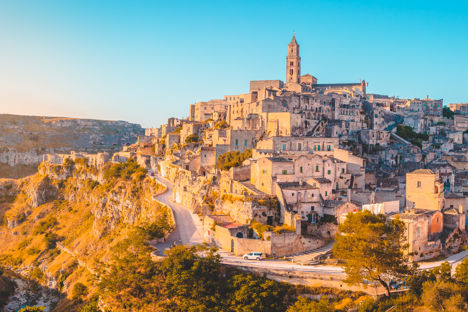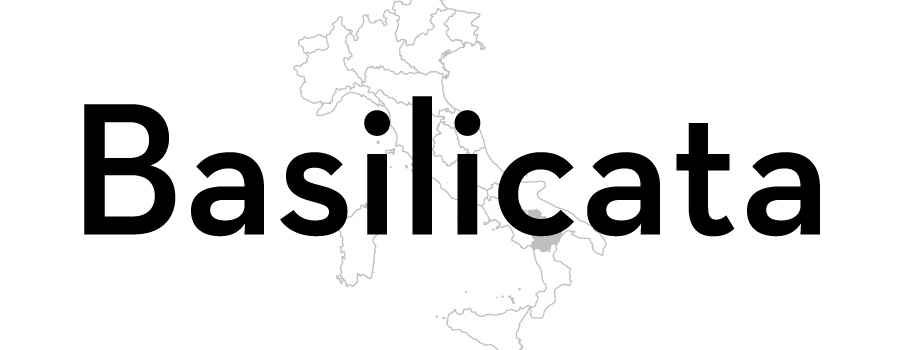
The complete foodie guide to Basilicata
This southern region is lesser known and far from the beaten tourist track, but visitors will find incredible historic towns, beautiful beaches and fantastic food that rivals the more popular parts of Italy.
The complete foodie guide to Basilicata
This southern region is lesser known and far from the beaten tourist track, but visitors will find incredible historic towns, beautiful beaches and fantastic food that rivals the more popular parts of Italy.
Whilst hundreds of thousands of us descend on Rome, Venice, the Amalfi Coast, Tuscany and the Ligurian coast each year, Basilicata remains one of Italy’s best-kept secrets. This part of Italy has always historically been very poor (the sweeping, jagged mountain landscapes don’t paint the most hospitable picture on the surface), but those willing to dive into this under-appreciated region will find Basilicata is rich with history and culture. From the ancient town of Matera – one of the oldest known human settlements in the world – to the secluded coves and beaches on the Ionian and Tyrrhenian coasts, stunning national parks and mysterious old ruins, Basilicata has something for everyone.
Even without the beautiful countryside, history and culture, Basilicata is still a hidden gem thanks to it being one of Italy’s most underrated food destinations. Most food in Basilicata starts with durum wheat in some context – grains have been cultivated here for thousands of years and as a result Basilicata has one of the oldest baking traditions in Italy. Bread has been made in Matera for almost as long as humans have lived there – perhaps as long ago as 7000BC – fermented in the town’s old cave dwellings before being baked over roaring wood fires. These days bakers use more modern, industrial equipment, but the recipes and the final results are much the same. A similar story goes for pasta – the oldest records of pasta refer to it being made in Basilicata, and the region claims a host of unique pasta shapes and dishes as its own, all made from ancient Basilicatan wheat.
Basilicatans are unashamedly proud of their bread and pasta, but this region is far more than just starchy carbohydrates. The climate is very similar to that in neighbouring Puglia, and as a result it makes for excellent vegetable growing – Basilicatans are blessed with outstanding vegetables year-round, and they make the most of quintessential Italian ingredients like tomatoes, artichokes and leafy greens. This is a very traditional region by all accounts, but the food takes influences from all over – there are Sicilian touches in some dishes with the use of raisins and pine nuts; the chilli-flecked heat of Calabrian cooking sometimes rears its head and there’s a reverence for cheese, cured meats and olive oil that matches the rest of Italy. Fish is less common as Basilicata’s coastlines are short, but meat is plentiful – lamb and mutton are both common, as is horse meat. Intrigued? Read on for more about this hidden gem.
Ingredients and flavours
Undoubtedly the defining flavour of Basilicata, these long peppers look like chillies but they’re actually sweet peppers. Occasionally they’re eaten fresh in soups and stews, but more often they’re strung up in huge clusters and hung from balconies and windows to dry out in the baking heat of the summer sun. Once dried, Senise peppers are fried and crushed to make peperoni cruschi – a vital seasoning in Basilicata that the locals add to almost everything, giving it a wonderful sweet and smoky flavour.
Meat is a big part of the diet in Basilicata. Lamb is especially popular here – as with the rest of Italy’s agricultural heartland there’s no lack of room for rearing animals, which allows farmers to keep large numbers of livestock. Lots of Basilicata’s oldest, most traditional dishes are focused around lamb and mutton, including spezzatino di agnello, where lamb is stewed in an earthenware pot with with potatoes, onions, bay leaves and peppers.
There’s also lucanica – a delicious pork sausage that is common all over the region. Lucanica has been made in Basilicata for thousands of years – since before Roman times – and these days you’ll find it both cured and fresh, made with hand-minced pork and pork fat as well as salt, pepper, fennel seeds and peperoni cruschi.
Soppressata is also said to originate in Basilicata, though it has become popular all over the country in the centuries since. The delicious spreadable spicy pork sausage is easily available in Basilicata, often sold preserved in jars of olive oil.
The aforementioned lamb and sheep also produce a variety of wonderful cheeses, including cacioricotta – a soft sheep’s cheese made in a similar way to ricotta – and the wonderful Pecorino di Filiano – a PDO-protected hard cheese from Filano in the north of the region.
On top of that, there’s the prize jewel of Basilicatan cheeses, Caciocavallo Podolico – a wonderful saddlebag-shaped cheese made from the milk of the Podolico cow. Podolico cattle graze on a bounty of herbs, nuts and grass, which gives the resulting cheese an incredible flavour – in fact, it’s one of Italy’s most prized (and most expensive) cheeses!
Basilicata is built on a foundation of wheat – the durum wheat varieties grown across the region are some of the oldest in Europe and they make fantastic flavourful bread. You’ll come across a huge variety of different breads if you travel around the region, but by far the most significant is pane di Matera – a wonderful bread from Matera that has been made by the residents of the town for several thousand years. Also worth a try is strazzata – a Basilicatan equivalent to focaccia, often baked with lard and lardons of bacon.
Emilia-Romagna is widely regarded as the spiritual home of pasta, but many Basilicatans will tell you that the earliest records of pasta are actually right here in the south. It certainly makes some sense – the abundance of durum wheat here makes for superb pasta, and there are over ten different types of fresh pasta produced regularly in the region, including well-known shapes like orecchiette and cavatelli, to more unique pastas like tapparelle – like a larger orecchiette – and lucane chiappute – a wider tagliatelle. As is often true of the south, the vast majority of pasta here is made without eggs, giving it a different texture to the richer fresh egg pastas found further north.
Basilicata doesn’t have the revered wine heritage of regions like Puglia, Tuscany and Sicily, but the climate certainly plays in its favour. Though the region doesn’t produce a huge amount, what it makes tends to be of a very high quality. Aglianico is one of Italy’s best-known grape varieties, and it thrives in the heat of Basilicata. Northern Basilicata is home to the region’s most famous wine – Aglianico del Vulture – which is hands down the finest example of a pure aglianico you’ll find anywhere, and certainly one of Italy’s top red wines.
Grown primarily around Vulture in the north of the region, marroncino di Melfi are some of the most sought-after chestnuts in Italy thanks to their large size and sweet flavour. Every year the town of Melfi celebrates these chestnuts at the Sagra della Varola festival by roasting them over open fires, then eating them alongside a lovely glass of Aglianico del Vulture.
Famous dishes
A stew of fried aubergines with potatoes, tomatoes and peppers, this Basilicatan classic is seasoned with Senise peperoni cruschi, giving it an incredible smoky aroma.
Arguably Basilicata’s most recognisable pasta dish, pasta mollicata has become popular all over the south of Italy. It’s a simple dish, but deceptively delicious – the sauce is made from a base of just onion, tomato, a splash of red wine and stale bread, though sometimes anchovies are added too. Add some pasta – usually bucatini – and a good splash of olive oil, and you have one of southern Italy’s most endearing pasta dishes.
This late winter to early spring dish comes in various guises; at its most rustic it can by a simple stew of artichokes, pancetta and broad beans, but sometimes you’ll get a whole artichoke stuffed with potatoes, broad beans and pancetta then braised in stock.
We’re all familiar with calzone, but the classic Basilicata filling takes a few cues from nearby Sicily, combining leafy chard with mozzarella, pine nuts and raisins with interesting sweet and salty results.
This is not pizza as you know it – rather, this is a flaky pastry pie, made with a delicious filling of eggs, Italian cheeses and cured meats. In Basilicata this is traditionally made on Good Friday and then eaten over the Easter weekend.
A truly unique dish, rafanata is essentially a frittata made with egg, potato, pecorino cheese and grated horseradish, the latter of which is referred to as ‘poor man’s truffle’ in the south. Rafanata is often served around Easter time, with the horseradish providing a nice warmth during the cooler spring months.
Similar in many ways to Tuscany’s acquacotta, acquasale is also a soup that uses up stale bread, but instead the underpinning broth is flavoured with onion, tomato and peperoni cruschi for that typical Basilicatan flavour. Eggs are then poached in the broth, before being served over the stale bread in bowls.
Lagane is a pasta shape – it’s not dissimilar to tagliatelle but it’s thicker and shorter, and often called sagne in other parts of Italy. The traditional way to eat lagane in Basilicata (and indeed Puglia and Calabria) is with legumes – often chickpeas – and a sauce of garlic, rosemary, onion, celery and breadcrumbs.
Lamb is a common meat in Basilicata and remarkably good quality. You’ll often see it cooked very simply – roasted or grilled with fresh vegetables and olive oil – but spezzatino is a delicious way to eat lamb in the winter months. Tougher cuts of lamb are stewed in a traditional earthenware pot with potatoes, onions, bay leaves and peppers.



